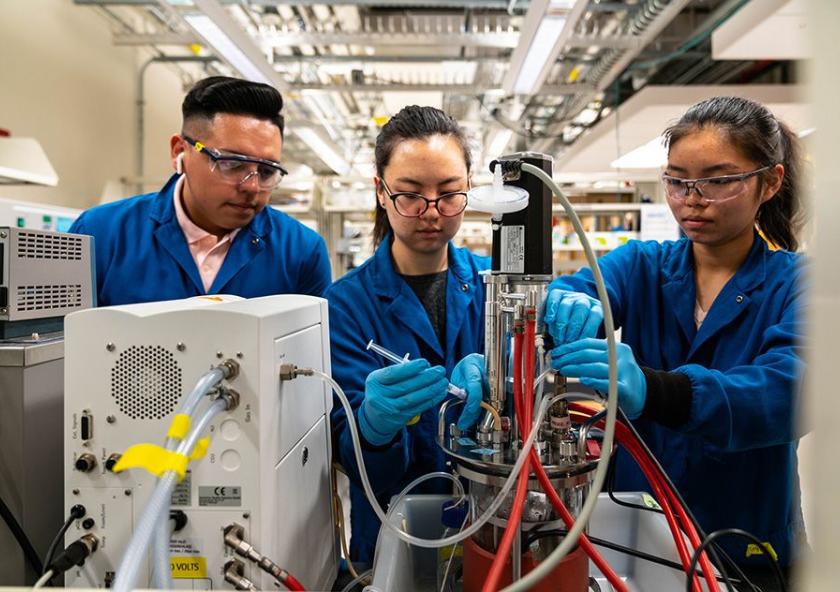
Making it real

Cloudy beige liquid swirls inside a large bioreactor resembling a French press as Jenna Ahn examines small flasks nearby. The lab where Ahn is working, in the subbasement of Building 66, has the feel of a beehive. She’s part of one of nine teams of undergraduates huddling in groups at their benches. Every now and then, someone darts off to use a larger piece of equipment among the shakers, spectrometers, flasks, scales, incubators, and bioreactors lining the walls.
These students aren’t practicing routine distillations or titrations set up by an instructor. Each team of three or four is trying to solve a problem that doesn’t yet have an answer. In 10.26/27/29 (Chemical Engineering/Energy/Biological Engineering Projects Laboratory), students are focused on data-driven, applied research projects. They work on engineering problems posed by companies and by research labs from across the Institute, with the goal of finding solutions that can be applied to the real world.
Ahn, a junior majoring in chemical and biological engineering, and her teammates are studying acid whey, a byproduct of cheese and yogurt. Although whey has nutritional value, it is often treated as a waste product, and its disposal can remove oxygen from waterways and kill aquatic life. While it can be purified and treated like wastewater, the process is expensive.
Ahn’s team is using genetically engineered yeast to break down whey into nutritious components like sugars and omega-3 fatty acids, which could then be introduced back into the food chain. After combining the yeast with the whey, the team regularly checks dissolved oxygen and pH levels and monitors whether the yeast is breaking down the whey into its components. “This could be turned into a component of animal feed for cows and other animals,” says Ahn, gesturing to the swirling the mixture in her flask.
Fundamentals in action
Gregory Rutledge, the Lammot du Pont Professor of Chemical Engineering, has been the instructor in charge of 10.26/27/29 (Chemical Engineering/Energy/Biological Engineering Projects Laboratory) for about five years. The excitement among the course’s students stems from the knowledge that they are directly contributing to advancing technology, he says. “It’s a great motivator. They may have gotten fundamentals in their classes, but they may not have seen them in action.”
The course has existed in its current form for about 30 years, Rutledge estimates. Its chemical engineering, biological engineering, and energy-related projects appeal to a wide variety of interests. Students are given project descriptions at the beginning of the semester and have flexibility in their choices.
In the current format, students give presentations on their research progress throughout the semester and are evaluated by the 10.26/27/29 professors and their peers. At the end of the term, final presentations are judged by faculty from the entire Department of Chemical Engineering during a project showcase.
The competitive element, Rutledge says, is just one part of how the course has changed over time. “It has evolved toward this organically, as we figure out what students need to know and how to best get that to them.”
Each year, the focuses of the students’ projects change. Two of this year’s teams are working in collaboration with Somerville, Massachusetts, startup C16 Biosciences, trying to use yeast to produce a sustainable alternative to palm oil. The production of palm oil, which is primarily used for culinary and cosmetic purposes, is a leading cause of deforestation.
“We’re trying to increase production of saturated fat sustainably,” explains Kaitlyn Hennacy, a junior majoring in chemical engineering. “This doesn’t require cutting down rainforests and could be a substitute in many applications.” Hennacy is examining a cuvette of yellow liquid in which there is a collection of bright orange blobs. The blobs’ color is a carotenoid pigment produced as a byproduct during the process. Her team is using seven different solvents, such as hexane and pentane, to extract a palm oil alternative from the yeast.
“It’s the intersection of an energy-related project and a consumer project,” says Carlos Sendao, one of Hennacy’s teammates and a fellow chemical engineering major. “This is a challenge I knew to take.” Sendao is going to continue research on this project over the summer through the Undergraduate Research Opportunities Program (UROP) and the MIT Energy Initiative.
Another team is looking into recycling plastics with an enzyme called PETase, which breaks down polyethylene terephthalate (PET), the type of plastic found in single-use water bottles. “One of the biggest constraints is time,” says Connor Chung, a junior majoring in chemical engineering. “We only have three to four months to learn as much as we can about this enzyme.”
Life lessons
Every year Rutledge is impressed with how much students learn and grow over the course of the semester. The problems they’re tackling aren’t easy, and working in teams presents challenges as students navigate the dynamics of group work.
“They’re also learning a lot about life. They’re probably going to run into something in the future — whether it’s a boss, a team member, or a piece of lab equipment — that doesn’t work in the way they expect,” he says. “We try to give the students the tools if or when they come across this. And when they give those final presentations, you can see they really have evolved as engineers,” he adds.
The approach seems to be effective, says Rutledge. “People will come back one, two, three years later when they’re working,” he says. “They say, ‘I learned so much. This is what I actually do.’”

